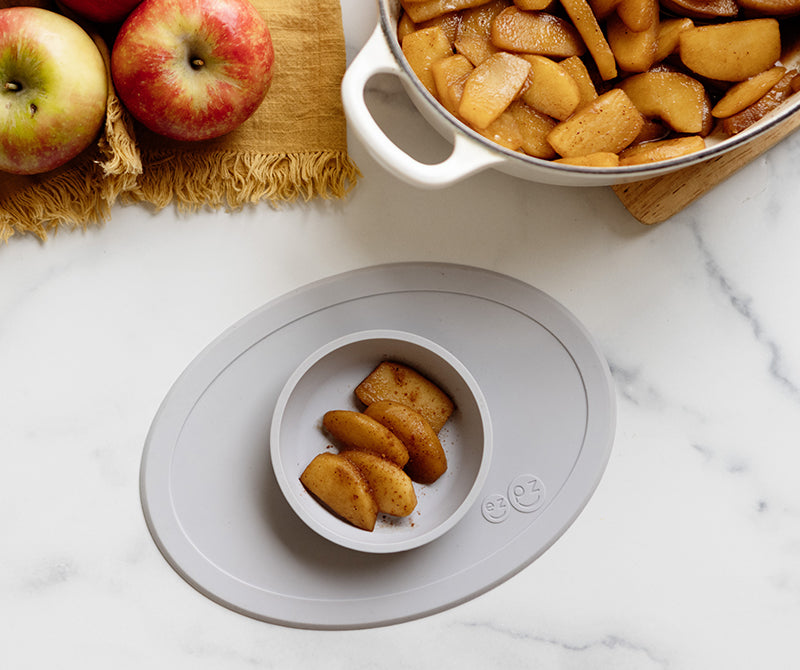Parents often ask me how to introduce an apple to their baby safely. Below I have outlined my expert feeding tips to avoid choking risk and to discover safe ways for baby to enjoy this beloved fall fruit!
Choking Concerns: Research shows that raw apples are among the most dangerous foods accidently being offered to a baby by their caregivers.
- Risks: Raw apples are considered to be dangerous due to the hard, crunchy texture, which poses a choking risk to your baby. But don’t let the risk scare you into only offering commercial applesauce or avoiding apples altogether! In fact, studies have found that the highest frequency of babies choking on food were actually the babies who were given finger foods the least often. So, if you feel more comfortable starting with thick apple puree (applesauce) that’s fine – just don’t get stuck on that texture. Keep reading for my other consistencies and textures!
Textures: Yes, a raw apple is a choking risk, but apples can be safely provided to your little one in other safe textures. Here are a few of my favorite ways to serve apple to baby.
- Cooked: Apples can be cooked in order to soften the texture. You will know that it’s cooked enough when you press the apple slice between your index finger and thumb and feel that it is flexible enough for baby to munch on with their gums. You read that right; babies do not need teeth in order to eat soft foods like cooked apples. They use the pressure from their gums to break food down, which is why it is important for caregivers to provide textures that are pliable.
- Lumpy Puree: You can make homemade applesauce by blending cooked apples in your food processor for a few minutes. This lumpy puree is a great texture to put on a baby-led spoon like the Tiny Spoon to practice self-feeding skills. This puree practice will help baby achieve their spoon-feeding milestones.
- Thin Puree: You can offer your baby a thin puree by placing the cooked apple slices in a blender with an ounce of breastmilk or formula. Then place the thin puree into a baby-led cup such as the Tiny Cup so baby can work on their open-cup drinking milestone.
- Grated: I like to grate apples and offer it as a sprinkle for babies. First, I remove the skin and seeds. Then I grate the flesh and sprinkle a small amount over yogurt, pancakes, waffles or oatmeal. This is a fun and sweet texture for baby to safely try!
- Liquids: The American Academy of Pediatrics recommends no apple juice for children under one year of age due to concerns regarding obesity and dental health. So please avoid offering your baby apple juice or apple cider.
Shapes + Spices: Did you know that changing the shape or taste of a baby’s food can help decrease choking risk? Yes! Different shapes, tastes and textures can help develop critical oral-motor skills that will aid in chewing and swallowing safely!
- Shapes: Avoid offering cooked apples cut in half, as this can lead to overstuffing and pose a choking risk. Ideally, you want to offer cooked apples cut to the length of your pinky finger and thinly sliced. I like to use a crinkle cutter on the edges of the cooked apple. This provides additional texture that can help a baby’s tongue push the apple onto the gumline. The grooves of the crinkle cutter also allow the baby to have a better grip (cooked apples can be a bit slippery).
- Spices: Feel free to add some spice such as cinnamon or nutmeg. This will enhance the sensory properties of the apple and allow your baby to find the food pieces more easily in their mouth. This sensory tip will help decrease choking risk even further.
How do you prepare apples for your baby? What are some of your baby’s favorite spices? Show us your apple creations by tagging us in your pictures with our hashtag #ezpzfun!



